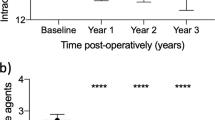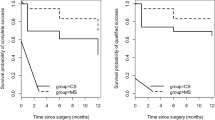Abstract
Purpose
To describe the use of intracameral phenylephrine to prevent the floppy iris syndrome seen in patients who are on the drug tamsulosin for benign prostatic hypertrophy, during cataract surgery.
Setting
Prince Charles Eye Unit, King Edward VII Hospital, Windsor, Berkshire, UK.
Method
Seven patients who were on systemic tamsulosin for benign prostatic hypertrophy received intracameral phenylephrine before capsulorexhis during their cataract surgery.
Results
There was a significant reduction in the amount of mobility of the iris, reduction in the expected fluttering, and sustained papillary dilatation.
Conclusion
Intracameral phenylephrine is a simple and effective tool to prevent the effects of floppy iris syndrome in those patients undergoing cataract surgery who are on systemic tamsulosin.
Similar content being viewed by others
Introduction
The intraoperative floppy iris syndrome (IFIS) is a recently described syndrome1 in patients who are on systemic tamsulosin (Flomax, Boehringer Ingelheim GmbH, Germany) for the treatment of lower urinary tract symptoms in patients suffering from benign prostatic hypertrophy(BPH).
This syndrome is a recently observed phenomenon in which there is excessive billowing and fluttering of the iris during phacoemulsification. There is also an increasing tendency for the iris to prolapse out through the side port incisions. These pupils do not dilate well either and progressively constrict during the course of the surgery.1
Conventional methods of preventing complications from floppy iris and poorly dilated pupils include use of iris hooks2 and spincterotomy3 among others.
We describe the use of intracameral phenylephrine at the beginning of the operation to prevent the occurrence of the floppy iris syndrome. This avoids the use of the more traumatic measures listed above, saves intraoperative time, and reduces complications.
Tamsulosin hydrochloride
Tamsulosin hydrochloride is a systemic sympatheticolytic, which acts by selectively antagonizing alpha-1-a receptors.4 The drug relaxes the smooth muscle in the bladder neck and prostate, improving urinary flow in patients with symptomatic BPH. It is ultraselective (uroselective) for the alpha–1 receptors in the prostate.5
Phenylephrine hydrochloride
Phenylephrine hydrochloride is a synthetic sympathomimetic structurally similar to epinephrine that acts predominantly on alpha-1 receptors.5 After topical or intracameral application, phenylephrine acts directly on the alpha-1 receptors to produce contraction the dilator muscles of the pupil, which produces papillary mydriasis (without significant cyclopegia). Maximal mydriasis from a single application of topical drug takes 60–90 min and recovery takes 5–7 h. Intracameral application acts immediately.

Patients and methods
Seven consecutive male patients who were on systemic tamsulosin for urinary symptoms due to BPH and were noted to have small pupils preoperatively (a significant sign of IFIS) were selected to receive phenylephrine intracamerally during cataract surgery.
Intracameral phenylephrine was prepared using 0.25 ml of minims phenlyephrine hydrochloride 2.5% (with sodium metabisulphite, sodium edentate, and purified water) mixed with 1.0 ml balanced salt solution. These were mixed into a 2 cm3 syringe.
The selected patients were given intracameral lignocaine 1% prior to phenylephrine injection to prevent pain. About 0.5–1.0 ml of intracameral phenylephrine preparation was then injected into the anterior chamber through the paracentesis incision site before injection of viscoelastic.
The effect on pupilary dilatation and the behaviour of the iris throughout the operation were noted. All cases were video recorded. The pupil size was measured from the video recordings in comparison with a standard 2.8 mm keratome as described by Lundberg and Behndig.6
Results
All seven patients had significant reduction in the signs of floppy iris syndrome.
A sustained pupilary dilatation was also noted in all cases. No case developed iris prolapse. None of the patients required any further measures like iris hooks, etc. None of the patients required repeat injections in our study.
All patients had been on tamsulosin for greater than 6 months duration. We did not discontinue tamsulosin in any of the patients prior to surgery.
Discussion
It is suggested that tamsulosin causes blockage of the alpha-1 receptors in the dilator muscle of the iris.1 This prevents the iris from dilating and accounts for its unstable nature intraoperatively.
Phenylephrine in its intracameral application saturates the alpha-1 receptors in the iris, causing it to dilate, and remain dilated throughout the surgery. It also reduces the tendency of the iris to prolapse.
This significantly reduces the need for more traumatic procedures, which are conventionally recommended for such cases, without any long-term effects. It also reduces intraoperative time and complications from surgery.
This study does have its limitations. It is a nonrandomized, noncomparative, nonblinded observational and interventional study. It also suffers from having a small sample size and observer bias. Furthermore, extensive studies need to be carried out to fully evaluate this method.
References
Chang DF, Campbell JR . Intraoperative floppy iris syndrome associated with tamsulosin. J Cataract Refract Surg 2005; 31 (4): 664–673.
Akman A, Yilmaz G, Oto S Akova YA . Comparison of various pupil dilatation methods for phacoemulsification in eyes with a small pupil secondary to pseudoexfoliation. Ophthalmology 2004; 111 (9): 1693–1698.
Bacskulin A, Kundt A, Guthoff R . Efficiency of pupillary stretching in cataract surgery. Eur J Ophthalmol 1998; 8 (4): 230–233.
GOODMAN & GILMAN'S. The Pharmacological Basis of Therapeutics, 10th ed. McGraw Hill: New York, 2001.
Lowe FC . Role of the newer alpha, -adrenergic-receptor antagonists in the treatment of benign prostatic hyperplasia-related lower urinary tract symptoms. Clin Ther 2004; 26 (11): 1701–1713 (review).
Lundberg B, Behndig A . Related articles, links intracameral mydriatics in phacoemulsification cataract surgery. J Cataract Refract Surg 2003; 29 (12): 2366–2371.
Author information
Authors and Affiliations
Corresponding author
Rights and permissions
About this article
Cite this article
Gurbaxani, A., Packard, R. Intracameral phenylephrine to prevent floppy iris syndrome during cataract surgery in patients on tamsulosin. Eye 21, 331–332 (2007). https://doi.org/10.1038/sj.eye.6702172
Received:
Revised:
Accepted:
Published:
Issue Date:
DOI: https://doi.org/10.1038/sj.eye.6702172
Keywords
This article is cited by
-
Intraoperative floppy iris syndrome and its association with various concurrent medications, bulbus length, patient age and gender
Graefe's Archive for Clinical and Experimental Ophthalmology (2017)
-
Intraoperatives Floppy-Iris-Syndrom: ein aktueller Überblick
Spektrum der Augenheilkunde (2016)
-
Modified corneal incisions in intraoperative floppy iris syndrome (IFIS)-prone patients
Graefe's Archive for Clinical and Experimental Ophthalmology (2016)
-
Komplikationsmanagement beim „intraoperative floppy iris syndrome“
Der Ophthalmologe (2013)
-
Correlation between urological alpha1-AR antagonist medication and changed intraoperative iris behavior
International Ophthalmology (2011)



